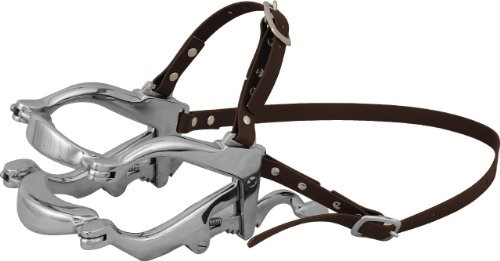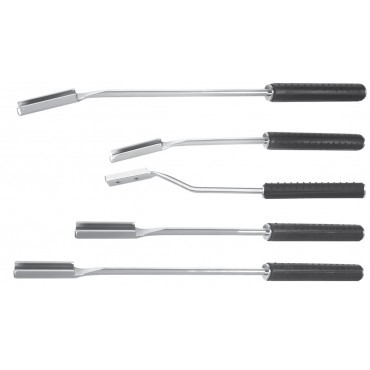Horses have teeth, which erupt continuously throughout most of their life. However, they are born with a finite amount of tooth to use, and as such, at some point late in their lives, their teeth will eventually wear out. Evolution has provided the horse with robust, strong grinding teeth. This is ideal for the horse's natural feeding behavior i.e. grazing for long periods of time on tough grass. Unfortunately, domestication of the horse, whereby they are fed on many varied diets, and not tough grass and vegetation means that they can experience certain types of dental problems which are rarely seen in wild horses. For example feeding stabled horses concentrates means that they spend a lot less time chewing compared to their wild relatives, and this can alter their pattern of chewing movements. The knock on effect of this is that it can upset the natural balance between tooth eruption and teeth wear, allowing sharp or overgrown teeth to develop. Routine dental care aims to address or prevent these problems.
Who is best to deal with your horse’s dental needs?
Your veterinary surgeon should always be your first port of call when it comes to looking after your horse’s teeth. Vets are trained in equine dentistry and unlike equine dental technicians can sedate horses, where required, to help optimize dental care.
How often should your horse’s teeth be checked?
The frequency of dental care really depends on the individual horse and its own individual requirements. Age and certain dental conditions may influence the frequency of dental examinations and treatment. However, it is a good idea to have your horse’s teeth examined at least once a year.
A common misconception is that horses younger than 5 years old do not require any dental treatment. However, up until the age of 5 years old the equine mouth is undergoing a lot of change with the shedding of deciduous (baby) teeth and the eruption of permanent teeth. As such it is still important to have regular dental examinations and treatment, where necessary, in these young horses.
Getting your horse ready for the examination
While some horses may tolerate routine dental examination and treatment quite well, with only restraint from a head-collar and competent handler, others do require sedation. Modern sedation drugs are very safe, and they allow for a more thorough and complete oral examination of your horse. Sedation also makes performing the required dental treatment much easier and safer for your horse, the vet and you.
Routine examination
Before starting any dental treatment, the vet will ask you about your horse’s ability to eat, and whether or not there have been any problems with dropping food etc. The incisors (front teeth) are easy to examine, just by parting the lips. However, it is more common for the grinding cheek teeth at the back of the mouth to develop problems. In order to perform a thorough examination, the vet will therefore use a specialist piece of equipment called a Haussmann’s gag (see figure 1), to open the horses’ mouth so that the cheek teeth can be inspected safely. The oral examination involves palpating (feeling) the teeth and gums as well as visually inspecting them. Specialist dental mirrors are commonly used in order to inspect parts of the mouth, which are otherwise hard to visualize.
Figure 1: Haussmann’s gag – used to perform a thorough oral examination

Common equine dental problems – sharp enamel points
In adult horses, where all of the teeth have erupted the most common dental problem is the formation of sharp enamel points.
Horses naturally chew their food in an elliptical fashion, with the grinding part of the cycle occurring during the sideways movement. With a diet mainly consisting of forage (similar to the diet of the wild horse) the horse chews in a sideways motion and this sideways motion (lateral excursion) is large, covering the whole of the grinding surface of the teeth, including the edges. This helps keep a horse’s teeth free from sharp enamel points, which would otherwise irritate and damage the oral mucosa (lining of the mouth). However, in domesticated horses which are fed concentrates, this sideways movement is often much less, and the horse doesn't tend to grind right to the edges of the teeth every time. Consequently, the tooth surface can therefore get worn away more quickly than the edges. This results in the edges of the teeth developing sharp enamel points. If present these will usually be found on the buccal aspect (cheek side) of the upper teeth, and the lingual aspect (tongue side) of the lower teeth. If these sharp enamel points are allowed to become too large, then they can lead to areas of ulceration on the adjacent mucosa.
Routine floating (rasping) of horse’s teeth
As previously mentioned the angled shape of a horse’s teeth and modern day diets, where less grinding of food is required, means that the buccal (cheek side / out side) edge becomes sharp on the upper teeth, and the lingual (tongue side / inside) edge becomes sharp on the lower teeth. These sharp enamel points can be painful and uncomfortable for the horse. If present, these sharp enamel points are reduced using either manual or mechanical floats (rasps) (see figure 2). In order to reach all the different teeth in the mouth a variety of floats of different angles, shapes and lengths will be have to be used.
In most cases the removal of sharp enamel points will be all that is required during a routine dental check-up. However, sometimes specific overgrowths of certain teeth may need to be addressed. The most commonly encountered type are 'hooks', which are where overgrowth and sharpness affects the first upper, and last lower cheek teeth.
Figure 2: Manual dental floats (rasps)

What are the signs and symptoms of dental problems in horses?
Sometimes horses may show very little in the way of obvious symptoms of dental disease until the disease is well established, hence why it is important to have regular dental examinations for your horse.
If your horse is showing any of the following signs it is highly suggestive that your horse is suffering from some form of dental disease:
• Dropping food (quidding)
• Pouching of food in the cheeks
• Halitosis (foul smelling breath)
• Discharge or smell from one or both nostrils
Apart from sharp enamel points and hooks, horses can also suffer from other more serious dental problems, such as an infection of the tooth root, a fractured tooth, a tooth that is growing in the wrong direction, or diastemata (food packing into spaces between the teeth). Your vet is the best and most qualified person to advise you on the most appropriate course of action for correcting your horse’s dental problems, and of course your vet is also able to treat these important conditions.
Most of the afore mentioned dental changes can be treated in the standing, sedated horse on the yard, but occasionally dental disease can necessitate more complicated surgery, which may have to be performed at an equine referral hospital.